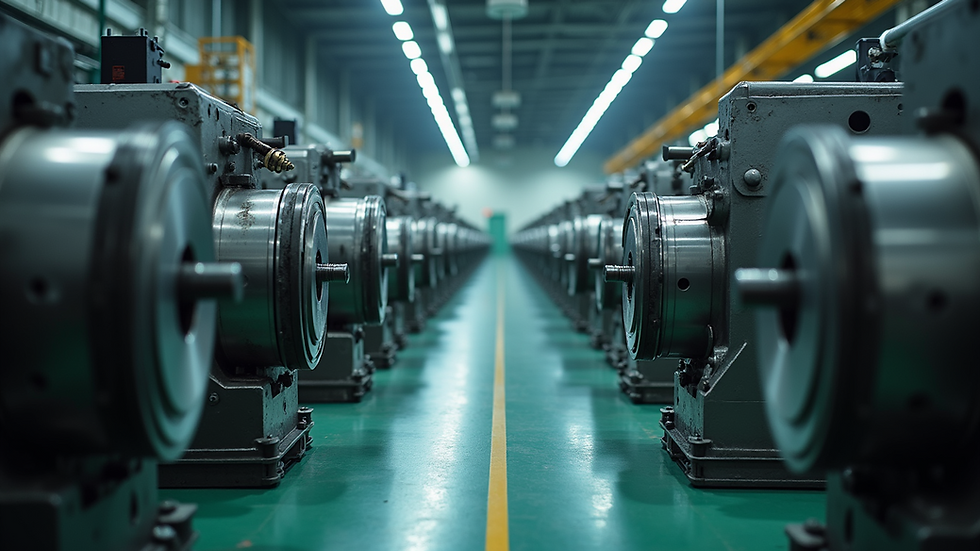Practical Applications of Die Casting in Modern Manufacturing
- EMPL

- Jul 28
- 4 min read
Die casting has become a cornerstone of modern manufacturing. Its precision, speed, and efficiency are unmatched, making it a popular choice in various industries. From automotive components to consumer electronics, die casting plays a significant role in producing high-quality parts that meet strict specifications. With this post, we will explore the many die casting uses in contemporary manufacturing processes.
Die Casting Uses
Die casting is a manufacturing process used to create metal parts through the injection of molten metal into a mold. This method allows for high precision and excellent surface finishes. Here are some common applications of die casting:
Automotive Industry: The automotive sector is one of the largest consumers of die-cast components. Engine blocks, transmission cases, and even decorative trims are often made using this process. In fact, according to the Aluminum Association, around 80% of aluminum die casting is used in vehicles.
Electronics: Modern electronic devices often utilize die-cast metal housings. These casings not only protect the sensitive inner components but also enhance aesthetics. Products like smartphones, laptops, and gaming consoles frequently rely on die casting for their durable and appealing enclosures.
Consumer Goods: Many household products like faucets, door knobs, and cookware are made using die casting. This method allows manufacturers to produce complex shapes with intricate designs, meeting both functional and visual standards.

What is Diecast Used For?
Die casting is employed in a variety of applications due to its ability to produce high-quality, complex metal parts efficiently. It is commonly used for mass production, where high volumes of parts are required.
1. Precision Engineering Parts
In industries that demand tight tolerances, such as aerospace and medical devices, die casting is an invaluable technique. Parts like valve bodies and pump housings are often created through die casting to ensure they meet the stringent requirements of their respective sectors.
2. Electrical Components
Many electrical components are made using die casting techniques. For instance, heat sinks used in computer CPUs and LED housings benefit from the thermal conductivity of metals, which are optimally produced through this process.
3. Furniture Hardware
Die casting is also applied to create hardware used in furniture, such as hinges, locks, and brackets. These components must be durable and reliable, characteristics inherent in die-cast products.

Advantages of Die Casting
The die casting process offers numerous advantages that make it a preferred option for many manufacturers:
1. High Efficiency and Speed
Die casting is known for its ability to produce parts quickly. Once the mold is created, parts can be produced in rapid succession, making it ideal for high-volume production runs. This speed translates to lower production costs.
2. Superior Surface Finish
Products created using die casting often require minimal post-processing. The high pressure used during the injection process results in a smooth surface finish that reduces the need for additional machining.
3. Complex Shapes and Designs
Die casting allows manufacturers to create intricate designs that would be difficult or impossible to achieve using other methods. This flexibility opens up a wealth of possibilities for product designers.
4. Material Efficiency
The die casting process minimizes waste by using only the necessary material to create parts. This is especially significant in industries where material costs can be a substantial portion of the overall expenses.

Die Casting Materials
When it comes to die casting, various metals can be utilized, each with its unique properties:
1. Aluminum
Aluminum is widely favored due to its lightweight and corrosion-resistant characteristics. It is commonly used in the automotive and aerospace industries, where weight savings are crucial.
2. Zinc
Zinc die casting is another prevalent choice, especially for small precision parts. It offers excellent dimensional stability and is often used for items like electrical components and hardware.
3. Magnesium
Magnesium alloy die casting is gaining popularity due to its strength-to-weight ratio. It is particularly useful in industries where reducing weight is a significant consideration, such as in automotive and aerospace applications.
The versatility of these materials enables manufacturers to select the best option for their specific needs, resulting in optimized performance and cost-efficiency.
Future Trends in Die Casting
As industries continue to evolve, so too will die casting techniques. Here are a few trends to keep an eye on:
1. Automation and Industry 4.0
The integration of automation and smart technologies into die casting processes is transforming manufacturing. Robotics can streamline operations, enhance safety, and increase production rates, further reducing costs.
2. Sustainable Practices
With an increasing focus on sustainability, the manufacturing sector is seeking eco-friendly practices. Die casting applications are being studied and improved for energy efficiency and waste reduction, aligning with the broader goals of sustainable manufacturing.
3. Advanced Alloys
The development of new metal alloys is expanding the possibilities for die casting. These advanced materials may offer improved performance characteristics, allowing manufacturers to produce even more specialized components for demanding applications.
In exploring the practical applications of die casting in modern manufacturing, it is evident that this process plays a pivotal role across various sectors. The combination of speed, efficiency, and versatility makes die casting a vital technology in producing high-quality parts that drive innovation and progress. For those looking to delve deeper into the various die casting applications, check out this resource.
Understanding the intricacies of die casting not only equips manufacturers with the tools to enhance their production capabilities but also opens doors to new advancements that will shape the future of manufacturing. As technology continues to progress, the significance of die casting in modern manufacturing will only continue to grow.




Comments